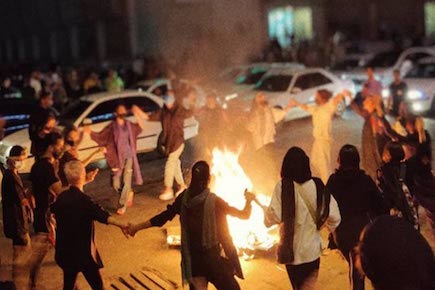
More than 80 Iranian cities have exploded in protest after the death of Mahsa Amini, who died after the nation’s notorious “morality police” arrested the 22-year-old woman for allegedly wearing her headscarf too loosely. Amini died on Sept. 16, three days after her arrest in Tehran. Many Iranians decried that she was beaten by police before she collapsed in a government run “re-education center.” Iranian officials deny Amini was assaulted, claiming she died after suffering a heart attack. But her family maintains that she did not have a pre-existing heart condition.
Women have been at the forefront of protests across Iran, with many burning their hijabs, or head scarves, in bonfires and others publicly cutting their hair. Protesters who openly condemn the Islamic Republic’s restrictions on women and government leaders have clashed with riot police, leaving at least 76 people dead and more than 1,200 arrested since the unrest began. This, the most serious challenge to Iran’s government since the outbreak of post-election protests in 2009, comes as talks between Washington and Tehran on reviving the International Iran nuclear agreement have stalled.
Between The Lines’ Scott Harris spoke with Ryan Costello, policy director with the National Iranian American Council, who examines the grievances behind the widespread protests in Iran and the determination of young people to change a system where many believe they have no future.
RYAN COSTELLO: It’s a really fast-evolving situation. And, you know, I think what’s one of the most remarkable things is that it’s largely led by Iranian youth. This is the future of their country. And they are standing up and protesting in a way that hasn’t been seen in Iran in years. You know, you can go back certainly to the 2009 Green Movement, which had, you know, I think similar levels of mass mobilization across society.
But those were centered on a rigged election. Essentially, this is more of an outright rejection of the status quo and the needs of the Iranian political system as a whole. And, women are at the forefront here as well. Mahsa Amini, 22 years old, never should have been arrested in the first place, but was targeted for improper hijab or an Islamic covering of their hair and brought in a police van to station and allegedly beaten in that police van so badly that she collapsed in the station, developed a coma and then died on Sept. 16.
So this really lit the flames of the protests and ignited the really fierce resentment that’s been building among the Iranian people toward the government of Iran for quite some time.
SCOTT HARRIS: Ryan, there are many defenders of this theocratic regime and others across the world who impose strict limitations on women justifying it by the Bible or the Koran and other religious texts. Do we have a situation in Iran where the culture has changed over these many years since the Islamic Republic was established after the overthrow of the shah of Iran?
RYAN COSTELLO: Well, I think it’s you know, it’s a little bit hard for us to say outside of the country, you know, exactly what are the sources of this and so forth. I think there’s always the grievances of these day-to-day encounters and the death of the young woman that’s lit the flame. You know, I think it’s important not to get too much into some of the Islamophobic critiques of the system and so forth.
But, on the ground in Iran, there are both hijabi-wearing women who voluntarily wear a chador, a hijab in public, who object to this mandatory hijab just as much as maybe younger women who are leading the charge on unveiling in public and participating in these protests. It’s kind of both sides of the spectrum.
It’s people who would personally choose to wear it and others who would not if it weren’t mandatory and enforced by state. And in some instances, fatal violence. But I do think there’s, you know, maybe not a cultural change, but a generational change happening in terms of this youngest population, kind of 18 to, early 20s, the Generation Z of Iran that reportedly being the name spearhead of these protests and so forth.
I think they have, you know, grown up and they’ve seen absolutely no outlets for change in their lifetimes with the Islamic Republic. That if they don’t make something happen themselves, they’re going to be under the system their entire lives, and they’re willing to put their lives on the line for that change, which is really, I think, quite remarkable when you think about the bravery that it takes to violate these laws at risk of arrest, you know, murder in the streets, torture in Iranian prisons.
You know, they’re standing up to their future. And, you know, I think it’s incumbent on the entire world, those of us in the United States diaspora to continue to speak up and condemn these human rights abuses and try to figure out a way to support them, but continue to allow the Iranian people to lead these organic protests.
I think what’s been remarkable is it seems like the reaction of the people on the ground in Iran is basically, “Don’t tell me the odds. It doesn’t matter what the odds are of success. We still need to fight for our rights and a better future because it’s the right thing to do. And if we die, will die.”
For more information, visit the National Iranian American Council at niacouncil.org.
Listen to Scott Harris’ in-depth interview with Ryan Costello (27:45) and see more articles and opinion pieces in the Related Links section of this page.
For the best listening experience and to never miss an episode, subscribe to Between The Lines on your favorite podcast app or platform: Apple Podcasts, Spotify, Stitcher, Google Podcasts, Amazon Music, Tunein + Alexa, Castbox, Overcast, Podfriend, iHeartRadio, Castro, Pocket Casts, RSS Feed.




